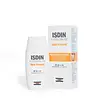What's inside
What's inside
 Key Ingredients
Key Ingredients

 Benefits
Benefits

 Concerns
Concerns

 Ingredients Side-by-side
Ingredients Side-by-side

Water
Skin ConditioningDibutyl Adipate
EmollientCyclopentasiloxane
EmollientOctocrylene
UV AbsorberAlcohol Denat.
AntimicrobialTitanium Dioxide
Cosmetic ColorantButyl Methoxydibenzoylmethane
UV AbsorberCyclohexasiloxane
EmollientBis-Ethylhexyloxyphenol Methoxyphenyl Triazine
Skin ConditioningButylene Glycol
HumectantPEG-30 Dipolyhydroxystearate
EmulsifyingNylon-12
PEG-10 Dimethicone
Skin ConditioningSodium Chloride
MaskingPhenoxyethanol
PreservativeSilica
AbrasiveDimethicone
EmollientDisteardimonium Hectorite
StabilisingPanthenol
Skin ConditioningTocopheryl Acetate
AntioxidantAllantoin
Skin ConditioningGlyceryl Stearate
EmollientParfum
MaskingDisodium EDTA
Ethylhexylglycerin
Skin ConditioningSodium Hyaluronate
HumectantDimethiconol
EmollientPEG-8
HumectantTocopherol
AntioxidantAscorbyl Palmitate
AntioxidantAscorbic Acid
AntioxidantCitric Acid
BufferingWater, Dibutyl Adipate, Cyclopentasiloxane, Octocrylene, Alcohol Denat., Titanium Dioxide, Butyl Methoxydibenzoylmethane, Cyclohexasiloxane, Bis-Ethylhexyloxyphenol Methoxyphenyl Triazine, Butylene Glycol, PEG-30 Dipolyhydroxystearate, Nylon-12, PEG-10 Dimethicone, Sodium Chloride, Phenoxyethanol, Silica, Dimethicone, Disteardimonium Hectorite, Panthenol, Tocopheryl Acetate, Allantoin, Glyceryl Stearate, Parfum, Disodium EDTA, Ethylhexylglycerin, Sodium Hyaluronate, Dimethiconol, PEG-8, Tocopherol, Ascorbyl Palmitate, Ascorbic Acid, Citric Acid
Water
Skin ConditioningSilica
AbrasiveButyl Methoxydibenzoylmethane
UV AbsorberButyloctyl Salicylate
Skin ConditioningDiethylhexyl Butamido Triazone
UV AbsorberEthylhexyl Salicylate
UV AbsorberEthylhexyl Triazone
UV AbsorberBis-Ethylhexyloxyphenol Methoxyphenyl Triazine
Skin ConditioningDicaprylyl Carbonate
EmollientDibutyl Adipate
EmollientCeteareth-25
CleansingCeteth-2
EmulsifyingDiethylamino Hydroxybenzoyl Hexyl Benzoate
UV FilterPotassium Cetyl Phosphate
EmulsifyingIsodecyl Neopentanoate
EmollientPolyester-7
Skin ConditioningGlyceryl Behenate
EmollientMethylpropanediol
SolventPotassium Azeloyl Diglycinate
Skin ConditioningLactobionic Acid
BufferingAlpha-Glucan Oligosaccharide
CleansingBisabolol
MaskingOryzanol
Skin ConditioningPinus Pinaster Bark/Bud Extract
AntimicrobialPolylysine
Caprylic/Capric Triglyceride
MaskingNeopentyl Glycol Diheptanoate
EmollientWater, Silica, Butyl Methoxydibenzoylmethane, Butyloctyl Salicylate, Diethylhexyl Butamido Triazone, Ethylhexyl Salicylate, Ethylhexyl Triazone, Bis-Ethylhexyloxyphenol Methoxyphenyl Triazine, Dicaprylyl Carbonate, Dibutyl Adipate, Ceteareth-25, Ceteth-2, Diethylamino Hydroxybenzoyl Hexyl Benzoate, Potassium Cetyl Phosphate, Isodecyl Neopentanoate, Polyester-7, Glyceryl Behenate, Methylpropanediol, Potassium Azeloyl Diglycinate, Lactobionic Acid, Alpha-Glucan Oligosaccharide, Bisabolol, Oryzanol, Pinus Pinaster Bark/Bud Extract, Polylysine, Caprylic/Capric Triglyceride, Neopentyl Glycol Diheptanoate
 Reviews
Reviews

Ingredients Explained
These ingredients are found in both products.
Ingredients higher up in an ingredient list are typically present in a larger amount.
You might know this ingredient as Tinosorb S or Bemotrizinol. It is a UV filter that covers both UVA and UVB rays.
This ingredient has two peak UV absorption peaks ( 310 and 340 nm) and is able to absorb both UV-A and UV-B rays. This ingredient works by preventing UV rays from reaching and damaging your skin.
On top of that - it is highly photostable and helps prevent the photodegration of other sunscreen ingredients such as avobenzone.
Tinosorb S is allowed in the EU, Australia, and Asia. It is close to being approved by the FDA and we'll hopefully get this ingredient in the U.S. by late 2025.
Fun fact: Tinosorb S is the most effective UV absorber at maximum concentration (measured by SPF) permitted in the EU.
This ingredient is oil-soluble, so your oil-cleansers will take this right off at night.
Learn more about Bis-Ethylhexyloxyphenol Methoxyphenyl TriazineAlso known as Avobenzone, this ingredient is a chemical sunscreen filter that provides protection in the UV-A range.
Avobenzone is globally approved and is the most commonly used UV-A filter in the world.
Studies have found that avobenzone becomes ineffective when exposed to UV light (it is not photostable; meaning that it breaks down in sunlight). Because of this, formulations that include avobenzone will usually contain stabilizers such as octocrylene.
However, some modern formulations (looking at you, EU!) are able to stabilize avobenzone by coating the molecules.
Avobenzone does not protect against the UV-B range, so it's important to check that the sunscreen you're using contains other UV filters that do!
The highest concentration of avobenzone permitted is 3% in the US, and 5% in the EU.
Learn more about Butyl MethoxydibenzoylmethaneDibutyl Adipate is an emollient and solvent. It is created from butyl alcohol and adipic acid.
As a solvent, Dibutyl Adipate helps mix and disperse ingredients evenly.
Dibutyl Adipate is soluble in water and organic solvents. It does not absorb UV rays.
Learn more about Dibutyl AdipateSilica, also known as silicon dioxide, is a naturally occurring mineral. It is used as a fine, spherical, and porous powder in cosmetics.
Though it has exfoliant properties, the function of silica varies depending on the product.
The unique structure of silica enhances the spreadability and adds smoothness, making it a great texture enhancer.
It is also used as an active carrier, emulsifier, and mattifier due to its ability to absorb excess oil.
In some products, tiny microneedles called spicules are made from silica or hydrolyzed sponge. When you rub them in, they lightly polish away dead skin layers and enhance the penetration of active ingredients.
Learn more about SilicaWater. It's the most common cosmetic ingredient of all. You'll usually see it at the top of ingredient lists, meaning that it makes up the largest part of the product.
So why is it so popular? Water most often acts as a solvent - this means that it helps dissolve other ingredients into the formulation.
You'll also recognize water as that liquid we all need to stay alive. If you see this, drink a glass of water. Stay hydrated!
Learn more about Water